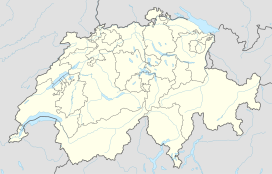Niesen mountain
| Niesen | |
|---|---|

The Niesen from Wimmis
|
|
| Highest point | |
| Elevation | 2,362 m (7,749 ft) |
| Prominence | 407 m (1,335 ft) |
| Isolation | 2.3 km (1.4 mi) |
| Parent peak | Albristhorn |
| Coordinates | 46°38′46″N 7°39′09″E / 46.64611°N 7.65250°ECoordinates: 46°38′46″N 7°39′09″E / 46.64611°N 7.65250°E |
| Geography | |
| Location | Bern, Switzerland |
| Parent range | Bernese Alps |
| Climbing | |
| Easiest route | Niesenbahn |
The Niesen is a mountain of the Bernese Alps in Switzerland. It overlooks Lake Thun, in the Bernese Oberland region, and forms the northern end of a ridge that stretches north from the Albristhorn and Mannliflue, separating the Simmental and Kandertal valleys.
Administratively, the summit is shared between the municipalities of Reichenbach im Kandertal, to the south-east, and Wimmis, to the west and north. Both municipalities are in the canton of Bern.
The summit of the mountain (2362 metres) can be reached easily by using the Niesenbahn funicular from Mülenen (near Reichenbach). The construction of the funicular was completed in 1910. Alongside the path of the Niesenbahn is the longest stairway in the world with 11,674 steps. It is open only once a year to the public for a stair run.
The literal translation of the German word Niesen is sneeze. Because of its shape, the Niesen is often called the Swiss Pyramid. The Niesen was the subject of a number of paintings by Paul Klee, in which it was represented as a quasi-pyramid.
...
Wikipedia

